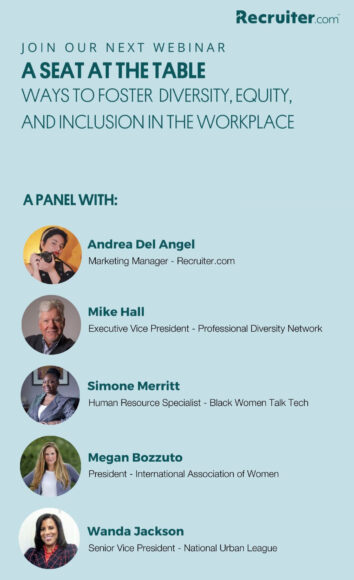A Seat at the Table: All You Need to Know to Foster DEI in the Workplace

Companies can become more competitive and attract top talent by finding new ways to foster diversity, equity, and inclusion (DEI) in the workplace. However, every company is different, and each needs to create its personalized plan.
Andrea del Angel, Recruiter.com ‘s marketing content manager, hosted a webinar panel with speakers from other companies on the importance of DEI and how companies can create an effective DEI strategy for their own companies.

Mike Hall, the Executive Vice President of the Professional Diversity Network, partnered with Recruiter.comto find the perfect panelists for this webinar. Megan Bozzuto, the President of the International Association of Women. Simone Merritt, the Human Resources and Operations Consultant for Black Women Talk Tech, and Wanda Jackson, the Senior VP of HR for the National Urban League. Each of these panelists works with DEI initiatives every day, and they provided some beneficial insights for companies interested in diversity.
What Are the Differences Between Diversity, Equity, and Inclusion?
Most businesses are likely familiar with the phrase D&I, but what does equity mean? Bozzuto had an excellent analogy for companies who wanted to understand DEI. She recommended that companies think of diversity as if it’s a party.
Workplace diversity is important because that’s when you invite everyone to the party. When you have inclusion, you provide a ramp to ensure everyone can get into that party. Equity is making sure that everyone has the proper access to be able to do everything at the party.
These are the three pillars to ensuring that you have an effective diverse company. Making sure you have all kinds of communities represented at your company essential, but it needs to go further. You want to give people the necessary tools to be successful in whatever position they have, regardless of what ethnicity, race, sexual orientation, or background they come from.
According to Jackson, this might mean providing certifications and coaching to marginalized communities.
Merritt argues that companies should focus on fostering diversity and fairness at their company. Leadership and management need to understand the diversity policies they’re implementing. They must find ways to elevate everyone at the company, regardless of their diverse backgrounds.
What Common Mistakes Do You Think People Are Making With DEI?
While having a DEI plan in place is very important for companies, there are many ways that you can go wrong. Some companies have never implemented a DEI plan before, and they may be wondering where to start. You can start by learning what mistakes to avoid early on to set your company up for success.
According to Merritt, the lack of action behind your words is one mistake that she sees companies make too often. While you might say that your company has an inclusive culture, do your employees agree with you? Keep in mind that 98% of companies say that they focus on diversity, but 25% of diverse workers say that they don’t see any benefits from diversity programs. If this happens at your company, it may be a sign that your efforts aren’t as effective as you think they are.
You should take a step back and analyze your company to ensure that your efforts work. For example, you might need to offer additional diversity training for employees. This might involve creating employee resource groups, and you must ensure everyone is treated fairly and has the same access. If you can point to a few things that you’re actively doing to create positive results, then you’re in a step in the right direction.
Another common mistake to avoid is not having any resources or budget available to fund your DEI efforts. Too often, companies will say that they have a program that values diversity, but there’s no funding to help them reach their goals. To try and obtain that funding, you may want to provide evidence of companies who found that they made more profits when they had a diversity initiative.
Another issue that companies don’t consider is the organization of the DEI committee. For example, is it just made up of high-level executives making the decisions for everyone? These managers and leadership may not have the best insights into what the companies need, so you should start asking for feedback at the bottom and work your way up.
You can do this by sending our anonymous surveys and asking employees for feedback.
“Start with the people who will benefit most,” Bozzuto said.
People at every level need to have difficult conversations and ensure everyone is working towards diversity efforts.
Once you have these systems in place, keep rechecking as well. Sometimes companies will set up diversity initiatives and then think they’re done. However, it’s “not a one and done,” said Bozzuto.
It’s a continuous process and journey, and your entire organization should work to support it.
What Can Companies Do to Make an Inclusive Environment That’s Genuine?
A crucial aspect of a diverse environment is ensuring it’s genuine. Candidates and employees can quickly tell if your diversity plan is just lip service, and this will start to show with lost productivity, lower engagement, and even quiet quitting.
To do this, you need first to understand what your employees need. According to Merritt, awareness and acknowledgment are vital to having a good DEI company culture. Leadership teams will need to be critical of themselves and try to address unconscious bias. However, they’ll also need to be receptive to employee feedback if they want to help progress their company.
And again, it can’t just be a “one-and-done” strategy, as Jackson pointed out. For example, she pointed out that some companies might have contributed to charity after the George Floyd crisis and never donated again, but candidates will be able to see through this strategy. You need to have a long-term strategy and create ongoing relationships with the right organizations. It might even be a three or five-year strategy.
Education is also crucial, as Bozzutto points out. You may need to bring in experts on diversity as a consultant for your business to help you grow. Use your employee’s feedback as a guiding point to what programs you need to work on. If you rely on current management to handle everything, you will only have a limited point of view to work from.
What’s the Most Difficult Part of Implementing a DEI Program?
One of the reasons companies struggle with implementing DEI programs is that they’re still relatively new in terms of being in business. There’s not one perfect plan for a company, but there are best practices that you can follow.
However, that requires having difficult conversations when most people don’t want to have them. People need to be in a position to say that they don’t know what someone’s experience could be like but also show how to best support that person and listen to their experience.
People need to “get comfortable being uncomfortable,” Bozzuto said. Employees will need to look at their personal biases to grow and be able to create an environment that is inclusive to all kinds of diverse groups. If management doesn’t uncover their own biases, achieving a diverse workforce will be an uphill battle.
Another difficult part of this that Jackson pointed out is getting people to buy into the program. Management will need to convince executive leadership that there’s a need for these programs so that they can get funding. However, you can fix that by asking employees for feedback. You can also use other surveys and studies to back up your argument.
Send out a quarterly survey and give employees multiple ways to provide feedback. You must constantly monitor this so you can make adjustments when needed. You might also find it hard to get people to help you achieve these goals, and you’ll need to hold them accountable. This way, it might be easier to see incremental growth and finally see the action happening from your diversity program.
What Are Creative Ways to Source Candidates from Underrepresented Communities?
Recruiting plays a crucial role in the diversity at your company because if you can’t source candidates from underrepresented communities, you won’t see much change in your diversity. However, if you haven’t recruited in those talent pools before, Bozzutto recommends going to those communities.
Take time to invest in those relationships with marginalized communities. You can’t show up once, but you must invest in these relationships. One example of a long-term solution would be to create scholarship programs or donate to charity to help the youth access higher education. You can invest in a future diverse talent pool in those communities.
Not only will they be familiar with your brand, but it will also promote your employer’s brand. You can have something tangible to point to when people ask what your business is doing to support its diversity initiatives. When you hire in these marginalized communities, you also show a younger generation that they can have specific roles and positions. You show them that someone who looks like them can do that job.
According to del Angel, following all these steps will make creating a relationship with this community easier because you’ve already taken care of all the other tasks.
You can also watch the webinar here to learn more about helping underrepresented candidates.
What Are the Long-term Benefits of Embracing DEI Initiatives?
To get buy-in and resources for your D&I initiatives, you must convince management that it’s worth it.
According to Jackson, having everyone at the table to begin with is one of the most significant benefits. Having everyone at the table is helpful because it can help you get different perspectives on problems. When you have everyone with diverse perspectives, problem-solving, and planning for the future, you can cover more bases and prepare for any blindsides.
Many companies also see better profits and financials when they implement these initiatives. For example, some research found that companies that were in the top quartile for racial and ethnic diversity were 35% more likely to outperform their industry’s median financial profits. More research also found that companies that promote diversity have 19% higher revenue than the companies that don’t promote it.One way you’ll have better profits is to have more engaged and happier employees, which leads to higher retention. It costs $4,700 to hire a new employee, which can significantly help your bottom line.
It’s also a great recruitment tactic. Gen Z and Millenials are very conscious of an employer’s devotion to creating diverse teams, and they look for a diverse workforce at companies now, especially since Millenials are some of the most diverse groups themselves. Not being positioned to focus on racial and gender diversity will hurt your chance of recruiting great new talent. This will also hurt your bottom line because you will have to put more effort into your hiring process, which can be costly.
If you’re still struggling with diversity recruiting, check out our services if you need help hiring great talent and want to save money! We are experts in all things recruiting and have the solutions to help you find your next great hire, including a powerful AI sourcing software that reduces unconscious biases in the hiring process. Contact us today to see which solution is best suited to your needs.
Get the top recruiting news and insights delivered to your inbox every week. Sign up for the Recruiter Today newsletter.

